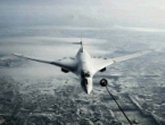
 The
Tu-160 supersonic strategic bomber was manufactured by the Tupolev
Aircraft Research and Engineering Complex Joint Stock Company
in Moscow and the Kazan based Gorbunov Aircraft Production Association
in Tatarstan between 1980 and 1992.
The
Tu-160 supersonic strategic bomber was manufactured by the Tupolev
Aircraft Research and Engineering Complex Joint Stock Company
in Moscow and the Kazan based Gorbunov Aircraft Production Association
in Tatarstan between 1980 and 1992.
The purpose of the aircraft is the delivery of nuclear and conventional
weapons deep in continental theatres of operation. The aircraft
has all weather, day and night capability and can operate at
all geographical latitudes.
WEAPON SYSTEMS
The Tu-160 can carry nuclear and conventional weapons including long range nuclear missiles. The missiles are accommodated on multistation launchers in each of the two weapons bays.
The Tu-16 is capable of carrying the strategic cruise missile Kh-55MS which is known in the West by the NATO designation and codename AS-15 Kent. Up to 12 Kh-55MS missiles can be carried, six in each bay. The Kh-55MS is propelled by a turbofan engine. The maximum range is 3,000 kilometres, and it is armed with a 200 kiloton nuclear warhead.
The weapons bays are also fitted with launchers for the Kh-15P which has the NATO designation and codename AS-16 Kickback. The Kh-15P Kickback has solid rocket fuel propulsion which gives a range up to 200 kilometres. The Kickback can be fitted with a conventional 250kg warhead or a nuclear warhead.
The aircraft is also capable of carrying a range of aerial bombs with a total weight up to 40 tons.
CONSTRUCTION
The bomber's airframe has a distinctive appearance with the wing and fuselage gradually integrated into a single-piece configuration. The airframe structure is based on a titanium beam all-welded torsion box. Throughout the entire airframe, all the main airframe members are secured to the titanium beam.
The variable geometry outer tapered wings sweep back from 20 to 65 degrees in order to provide high performance flight characteristics at both supersonic and subsonic speeds. The tail surfaces, both horizontal and vertical, are one piece and all-moving.
The aircraft uses fly-by-wire controls.
COCKPIT
The crew of the Tu-160 comprises a pilot and copilot, a navigator and an operator. The four crew are equipped with zero/zero ejection seats which provide the crew with the option of ejecting safely throughout the entire range of altitudes and airspeeds including when the aircraft is parked.
In the cockpit and cabins all the data is presented on conventional electromechanical indicators and monitors and not head-up-displays or cathode ray tube displays.
The Tu-160 has a control stick for flight control as used in a fighter aircraft rather than control wheels or yolks which are usually used in large transporter or bomber aircraft.
AVIONICS
The aircraft is highly computerised and the avionics systems include an integrated aiming, navigation and flight control system, with a navigation and attack radar, an electronic countermeasures system, and automatic controls.
ENGINES
The aircraft propulsion system consists of four NK-32 augmented turbofan engines, which each provide a maximum thrust of 25,000 kg. The engines are installed in two pods under the shoulders of the wing. The air intake incorporates an adjustable vertical wedge. The bomber has an in-flight refuelling system. In the inoperative position the refuelling probe is retracted into the nose of the fuselage in front of the pilot's cabin. The aircraft fuel capacity is 160,000 kg.
LANDING
The aircraft is equipped with three-strut landing gear, a tail wheel and a brake parachute. For take-off the aircraft requires a concrete runway of length 3,050 meters.
PERFORMANCE
The performance of the Russian Tu-160 is often compared to
the US B-1B. The aircraft has an operational range of 14,000
kilometres and a service ceiling of 16,000 metres. The maximum
flight speed is 2,000 kilometres per hour at high altitude, and
1,030 kilometres per hour at low altitudes.
The Tu-160`s navigation and aiming complex allows the aircraft
to perform automatic flight and weapons release by day and night
in all weathers. The Tu-160 has a doubled inertial navigation
and digital multi-channel communications systems, as well as
powerful electronic warfare complex. The electronic optical sight
provides a highly-accurate bombing in daylight and moderate luminosity
conditions. In the future the aircraft may be fitted with laser
designator system for aiming laser-guided munitions.
Twelve X-55 compact winged cruise missiles are placed in two launchers inside of the fuselage. Alternatively, the bomber can carry missiles of other types, or guded and free-fall bombs, or other means of destruction, which makes it effective against ground and sea targets.
The Tu-160 first flew in prototype form on December 19, 1981,
and bears a surprising resemblance to the B-1B
Lancer. The aircraft features a similarly slim fuselage blended
into its variable-geometry wings, as well as four turbofans housed
in pods beneath each wing in pairs.
Production of the aircraft ended in 1992, with a total of 18
entering service. The Tu-160 is the world's largest bomber to
date.
Prime contractor: Tupolev Design Bureau
Nation of origin: Soviet Union
Function: Bomber
Crew: 4
Year: 1981
In-service year:
Engine: Four Samara/Trud NK-321 afterburning turbofans, 50,580
lb thrust each
Wing span:
Fully spread: 55.7 m / 182 ft 9 in
Fully swept: 35.6 m / 116 ft 10 in
Length: 54.1 m / 177 ft 6 in
Height: 13.1 m / 43 ft
Weight: 242,500 lb empty / 606,260 lb max. take off
Ceiling: 49,200 ft
Speed: 2,220 km/h / 1,380 mph / Mach 2
Range: 12,300 km / 7,640 miles unrefuelled
Armament: Up to 36,000 lb including free-falling bombs, Kh-15P
short-range attack missiles, and Kh-55 cruise missiles